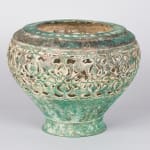Seljuk Incense Burner , Twelfth Century AD
Bronze
19.5 x 24.5 cm
7 5/8 x 9 5/8 in
7 5/8 x 9 5/8 in
CB.3028
Further images
This highly decorative bronze incense burner dates from the time of the Seljuks, a high mediaeval Turco-Persian people who, at their height in the AD 1090s, dominated an area from...
This highly decorative bronze incense burner dates from the time of the Seljuks, a high mediaeval Turco-Persian people who, at their height in the AD 1090s, dominated an area from the Levantine coast to Afghanistan and India. The Empire was founded in 1034 by Tughril, who ruled alongside his brother Chaghri and uncle Musa Yabghu. But the time of the Seljuks was to be brief; by the Twelfth Century AD, the Empire was in decline, and was supplanted by the Khwarazmian Empire in AD 1194. This brief period of dominance, however, accompanied an artistic flourishing, especially in metalwork and in a form of pottery known as mina’i-bowls.
The incense burner is decorated with a ring of circles around the rim, followed by a calligraphic Arabic inscription, above fretwork in the form of floral patterns surrounding roundels containing a quatrefoil decoration. The next register is a geometric design interlaced with more floral elements, above a solid base. The piece is in good condition, with an attractive green patina. This design owes more to Persian style than to the Turkic roots of the dynasty; the Seljuks disowned the artistic traditions of the Turkic culture, and the dynasty that originally celebrated its Turkic ancestry soon succumbed to Persification.
This piece is a testament to the mixed culture of the Seljuk dynasty, and to the imagination and skill of the local metalworkers. Incense burners were a common subject of Seljuk art, often taking the form of imaginative shapes like lions (Metropolitan Museum of Art 48/1981) or birds (Israel Museum B64.09.3692). Incense was widely used in the Islamic world; at special events, guests would be wafted with incense from burners like these on arrival. This incense burner probably, therefore, belonged to an elite personage at the pinnacle of Seljuk society.
References: similar incense burners can be found in Bamberg (University Museum of Islamic Arts BC 1975), New York (Metropolitan Museum 1975.314), Herat National Museum (01.18.56, 01.30.86a).
The incense burner is decorated with a ring of circles around the rim, followed by a calligraphic Arabic inscription, above fretwork in the form of floral patterns surrounding roundels containing a quatrefoil decoration. The next register is a geometric design interlaced with more floral elements, above a solid base. The piece is in good condition, with an attractive green patina. This design owes more to Persian style than to the Turkic roots of the dynasty; the Seljuks disowned the artistic traditions of the Turkic culture, and the dynasty that originally celebrated its Turkic ancestry soon succumbed to Persification.
This piece is a testament to the mixed culture of the Seljuk dynasty, and to the imagination and skill of the local metalworkers. Incense burners were a common subject of Seljuk art, often taking the form of imaginative shapes like lions (Metropolitan Museum of Art 48/1981) or birds (Israel Museum B64.09.3692). Incense was widely used in the Islamic world; at special events, guests would be wafted with incense from burners like these on arrival. This incense burner probably, therefore, belonged to an elite personage at the pinnacle of Seljuk society.
References: similar incense burners can be found in Bamberg (University Museum of Islamic Arts BC 1975), New York (Metropolitan Museum 1975.314), Herat National Museum (01.18.56, 01.30.86a).









